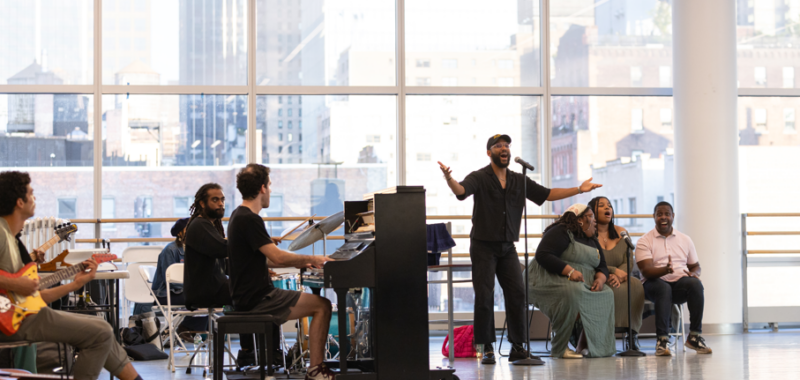The version we know today of Alvin Ailey’s Revelations, presented continuously for more than six decades on stages around the world, is only about half the length it was when it premiered in 1960. Nine songs, originally performed live, were cut from the score in order to tighten the production for a tour of Asia and Australia, sponsored by the U.S. government while John F. Kennedy was president.
This and other aspects of Ailey’s extraordinary career are being celebrated at the Whitney Museum of American Art, where the “Edges of Ailey” exhibition is on display through early next year. One of many related performances is a new work choreographed by Ailey interim artistic director Matthew Rushing to an original score by Du’Bois A’Keen. In Sacred Songs, Rushing and A’Keen collaboratively reference and reimagine Revelations’ nine deleted scenes. An accomplished dancer himself, A’Keen is one of the few Urban Bush Women alumni who identify as male; he’s also the lead vocalist and music director for Sacred Songs’ four vocalists and four-piece band. Ailey’s main company will present the piece at New York City Center, December 20–January 3.


Doing research is important, especially for this project. I brought questions like “Where do spirituals come from?,” “Why did people write spirituals?,” “What were enslaved people navigating?” I build up answers so that I have context and things to reach out from.
I started as a singer. I did musical theater and was in show choir, classical, gospel—all of the choirs. I grew up in the Black church and was a jazz singer. I started pursuing dance later, but even when I got the job with Urban Bush Women, we did a lot of singing there, too. I’ve always had very connected relationships with dance and voice, and how they can live in the same space. When I’m singing, I’m always moving—my body is all over the place, wiggling and jiggling. This work feels so personal to me because it’s both a culmination and a confluence of everything I’ve done up to this point. It’s an opportunity for me to bring all of those sonic and musical frameworks together.
Matthew is a dream collaborator—one of the most kind, generous, and open artists I’ve ever worked with. He’s receptive and treats me like an equal, and our process has been so symbiotic. We’ve been meeting before rehearsals to help each other think through the arc of the piece. I can share my thoughts about the concept and some of the choreographic moments, while he’s giving me feedback on the music and language. There’s a lot of mutual respect and trust, so it’s been really fulfilling.
Whatever creative space I’m in, I like to get there at least an hour early. I just need to be in the room, maybe playing loud music, maybe rolling around on the floor.
I’m a part-time comedian and Matthew loves laughing, so these rehearsals have been a lot of fun. He eggs me on.
I think of life as a creative process, honestly, and that’s not just me being poetic. It really is my lens. I love fashion—I’m always thinking about clothing. Outside of music, I’m a writer, a published author, and I write poetry. I used to journal with pen and paper, though now I just type. I made drawings as a kid, and that’s still there too. Getting my 5-year-old daughter to school on time is a creative process in itself. Being a good husband to my brilliant scientist wife is a creative process. All of that is me just trying to improve my way through life.

